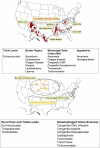Neglected infections of poverty in the United States of America
- PMID: 18575621
- PMCID: PMC2430531
- DOI: 10.1371/journal.pntd.0000256
Neglected infections of poverty in the United States of America
Abstract
In the United States, there is a largely hidden burden of diseases caused by a group of chronic and debilitating parasitic, bacterial, and congenital infections known as the neglected infections of poverty. Like their neglected tropical disease counterparts in developing countries, the neglected infections of poverty in the US disproportionately affect impoverished and under-represented minority populations. The major neglected infections include the helminth infections, toxocariasis, strongyloidiasis, ascariasis, and cysticercosis; the intestinal protozoan infection trichomoniasis; some zoonotic bacterial infections, including leptospirosis; the vector-borne infections Chagas disease, leishmaniasis, trench fever, and dengue fever; and the congenital infections cytomegalovirus (CMV), toxoplasmosis, and syphilis. These diseases occur predominantly in people of color living in the Mississippi Delta and elsewhere in the American South, in disadvantaged urban areas, and in the US-Mexico borderlands, as well as in certain immigrant populations and disadvantaged white populations living in Appalachia. Preliminary disease burden estimates of the neglected infections of poverty indicate that tens of thousands, or in some cases, hundreds of thousands of poor Americans harbor these chronic infections, which represent some of the greatest health disparities in the United States. Specific policy recommendations include active surveillance (including newborn screening) to ascertain accurate population-based estimates of disease burden; epidemiological studies to determine the extent of autochthonous transmission of Chagas disease and other infections; mass or targeted treatments; vector control; and research and development for new control tools including improved diagnostics and accelerated development of a vaccine to prevent congenital CMV infection and congenital toxoplasmosis.
Conflict of interest statement
PJH is Executive Director of the Global Network for Neglected Tropical Disease Control (GNNTDC), the Director of the Human Hookworm Vaccine Initiative (HHVI), and President of the Sabin Vaccine Institute. He is an inventor on an international patent for a hookworm vaccine. The author recused himself from all editorial decisions regarding this paper.
Figures
References
-
- Armstrong GL, Conn LA, Pinner RW. Trends in infectious disease mortality in the United States during the 20th century. JAMA. 1999;281:61–66. - PubMed
-
- Humphreys M. Malaria: Poverty, Race, and Public Health in the United States. Baltimore and London: Johns Hopkins University Press; 2001. pp. 49–68.
-
- Hotez PJ, Molyneux DH, Fenwick A, Kumaresan J, Ehrlich Sachs S, et al. Control of neglected tropical diseases. N Engl J Med. 2007;357:1018–27. - PubMed
-
- Hotez PJ, Ferris MT. The antipoverty vaccines. Vaccine. 2006;24:5787–99. - PubMed
MeSH terms
LinkOut - more resources
Full Text Sources
Other Literature Sources
Medical


